Enhancing System Reliability and Battery Longevity through Integrated Energy Sources and Algorithmic Optimization
Abstract
This research examines the enhancement of low power electronic systems, such as low power wide area networks (LPWANs), by incorporating a mix of renewable energy sources like solar and wind in China. It addresses the challenges posed by the variability of these sources due to climatic and temporal factors by merging diverse energy harvesting (EH) methods to bolster power stability and availability. The study assesses the most effective combination of solar, wind, and rain EH for steady power supply. A novel algorithm is introduced for energy input management based on real-time resource availability, with the goal of prolonging battery life by avoiding complete charge or discharge cycles. The feasibility of this multisource approach in possibly reducing the need for extra energy storage is evaluated. The investigation includes simulations using Chinese weather data to explore different combinations of energy sources. A real-life system utilizing solar and wind energy, guided by the developed algorithm, was also implemented for empirical comparison. Findings suggest that solar and wind energies have a higher power yield than rain harvesting, with actual wind energy collection often falling short of simulated forecasts. The solar–wind energy mix achieves a 99% system availability and facilitates a more compact design owing to their high power density. Although the input-switching algorithm lessens the frequency of complete battery drainage, a small degree of energy storage is still essential for maintaining system reliability. This integrated EH method, compared to single-source options, allows for a smaller energy storage requirement. Moreover, the algorithm limits battery charging to 80%, significantly enhancing battery lifespan.
1. Introduction
The advancement of low power wide area networks (LPWANs) in the internet of things (IoT) sector marks a significant stride towards combining reduced energy usage with extensive network coverage. Key to applications in urban development and agricultural technology, LPWANs operate under the limitation of low data transmission rates, a necessary compromise for energy savings. The capacity of LPWAN nodes to operate solely on battery power has transformed their deployment, facilitating installations in varied and isolated areas [1].
A pivotal aspect of LPWANs lies in the limited lifespan of their primary energy source, batteries. This challenge has given rise to the field of energy harvesting (EH), which employs natural sources like solar and wind power to energize network nodes. EH is a rapidly growing research domain, examining diverse energy sources, each with specific advantages and drawbacks [2]. For example, solar power, dependent on photovoltaic technology, is sustainable but subject to weather fluctuations and daily light cycles, shown in Figure 1.
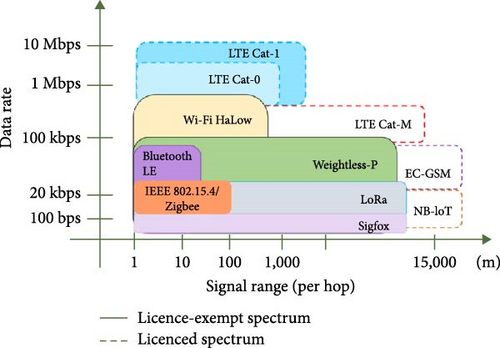
Focusing on real-world applications, LoRaWAN, under the LPWA network umbrella, is recognized for its efficient long-range communication. Its utilization of chirp spread spectrum (CSS) modulation provides substantial interference resistance, making it applicable across various scenarios [3]. An illustrative application is its projected use in a water level monitoring project in China, moving from 3G to LoRaWAN to achieve greater cost efficiency and reduced energy usage.
The dependency of EH technologies on environmental conditions presents considerable challenges. The variable nature of weather, for example, affects the dependability of solar and wind power sources. Contemporary studies indicate that integrating multiple EH sources can yield more stable power supply, though it increases system intricacy [4]. This complexity can be addressed by implementing intelligent algorithms for selecting energy sources and managing batteries, potentially enhancing energy use and possibly eliminating the need for conventional energy storage.
This study aims to investigate the deployment of a smart source selection algorithm in a multi-input EH LoRa node, focusing on improving energy efficiency and prolonging battery life. The research seeks to identify the optimal mix of EH techniques for a LoRa node and develop an algorithm for adaptable energy source selection. Furthermore, the paper examines the wider effects of these technologies on sustainability and ethical considerations in the IoT sector [5]. Highlighting renewable energy sources and lessening maintenance demands, the study contributes to global environmental conservation efforts, while being cognizant of the potential environmental ramifications of these technologies.
This research is tailored to the environmental conditions of China, using simulation models to mimic energy flow and component interaction dynamics. These models integrate efficiency metrics and environmental data to accurately depict the system’s performance in various scenarios. The objective is to provide insights into refining LPWANs for energy efficiency, thereby, enriching the dynamic landscape of IoT technologies.
2. Related Work
In the realm of IoT and LPWANs, a pivotal area of research is the optimization of EH and power management. This study contributes to this growing body of knowledge by examining various EH sources and power management strategies [6]. While the broader topic encompasses a range of related works, this particular section delves into research specifically pertinent to the questions at hand.
The evaluation of different EH sources forms a foundational aspect of this research. Several studies have conducted comparative analyses of these sources, focusing on parameters like power density [7], shown in Figure 2. However, there is a notable variation in how these comparisons are presented, with some studies focusing on peak powers, which may not fully represent practical scenarios. For instance, certain research papers [8, 9] have compared energy sources based on power per area for technologies like solar cells and radio frequency (RF) energy, while others have considered power per volume for sources such as piezoelectric materials. A recurring theme in these comparisons is the prominence of solar power, which consistently emerges as a high-density energy source [10]. However, the methodologies behind these comparisons often remain ambiguous, with a mix of average and peak power values, and a blending of power per volume and power per area metrics.
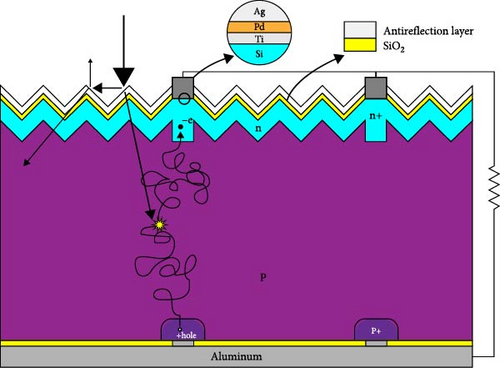
Research in power management systems has concentrated on creating and evaluating diverse frameworks suitable for handling multiple inputs in EH settings. These investigations have delved into a range of designs, including the voltage level detection strategy. This method bears resemblance to the power management technique employed in the referenced study but distinguishes itself by prioritizing voltage over power as its main comparative criterion [11]. The performance of these systems often depends on the changeability of the surrounding energy sources. Notably, the shared inductor DC–DC converter stands out due to its efficiency in merging energy from various sources and its proficiency in maximum power point tracking (MPPT) [12].
Furthermore, the concept of using capacitors for energy storage in each EH source has been proposed [13]. This method ensures that energy is not wasted when the harvester is disconnected, as the stored energy in the capacitor is used to charge the battery once it reaches a specific voltage level. However, it is noted that such systems may not fully utilize MPPT [14].
In the development of wireless sensor networks (WSNs), some research has integrated a mix of solar, wind, and fuel cell inputs [15]. Each input is regulated through individual DC–DC boost converters, with the outputs connected in parallel, allowing for the effective combination of energy from all sources.
The core objective of power management algorithms in this field is to maximize harvested power, thereby reducing the risk of battery discharge and increasing system up time [16]. This is particularly crucial in systems reliant on multiple EH sources. An adaptive sampling algorithm for network nodes has been suggested as an alternative approach in scenarios where diverse sources cannot be utilized. This algorithm dynamically adjusts system activity to prevent complete battery discharge, ensuring constant system operation despite reduced transmission frequency during low battery states.
Various strategies for regulating power from multiple sources have been suggested, varying in their complexity of control systems. For example, the Power OR-ing design is a passive approach mainly dependent on MPPT control [17]. In contrast, the shared inductor DC–DC converter necessitates extra control for MPPT on each input, yet it eliminates the need for algorithms to switch between inputs.
In summary, this exploration into related works underscores the diverse and complex nature of EH and power management in IoT applications [18, 19]. By examining various energy sources, architectures, and algorithms, this paper contributes to the advancement of sustainable and efficient power management strategies in the context of IoT landscape.
3. Implementation
3.1. Power Management Algorithm
In the study of power management for energy-harvesting systems, a nuanced approach is essential for optimizing battery life and energy efficiency. The core objective of this algorithm is twofold: first, to harness energy from the most potent source available and second, to enhance battery longevity through specialized charging strategies. These objectives align with the overarching goals of the study, which includes the evaluation of such algorithms [20].
- (1)
Halting EH when the state of charge (SoC) of the battery surpasses a predefined threshold. This action ensures the rest of the system operates normally while preventing overcharging.
- (2)
Reducing power consumption when the battery’s SoC falls below a certain point. This includes suspending message transmissions and monitoring activities, thereby slowing down the discharge rate and averting total depletion of the battery’s charge.
Implementing these SoC boundaries necessitates the use of a battery with marginally higher capacity, but this is a tradeoff for extended battery life.
- (1)
Monitoring the storage voltage to ensure it does not fall too low.
- (2)
Selecting an energy source based on its power output.
- (3)
Checking if the storage voltage is excessively high.
- (4)
Sending data messages using LoRa technology.
- (5)
Entering a low-power sleep mode, predetermined to last for 15 min.
For a more granular understanding, the algorithm’s process flow is delineated in flow charts, shown in Figure 3. The implemented algorithm, as encoded into the microcontroller, begins by assessing if the SoC is below a minimum threshold. If so, all energy harvesters are activated, and the microcontroller enters a sleep state, awaiting an interrupt signal, such as a timer set to wake the system every 15 min.
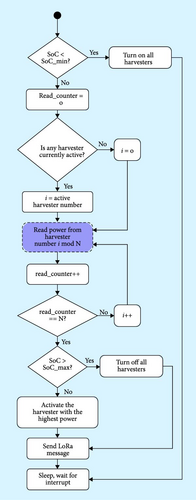

If the SoC is at an acceptable level, the system analyzes the power from each EH source. Priority is given to measuring the power from the source currently in use for its efficiency, avoiding the need for the MPPT circuit to adjust. This circuit, utilizing the fixed open circuit voltage (FOCV) approach, can take up to 16 s in extreme cases to locate the most efficient power point.
To counter potential inaccuracies in power readings during the MPPT’s sampling phase, a protective mechanism is in place. Should the initial power reading be zero, indicating an error, a follow-up reading is taken after a short interval [21]. The algorithm then selects the higher of these two values to ensure a precise power measurement.
After analyzing the output from each energy harvester, the algorithm checks if the SoC is overly high. If it is within acceptable limits, it activates the harvester with the greatest output [22]. Subsequently, the system dispatches a LoRa message detailing the harvested power, battery voltage, and the energy source in use, before entering sleep mode.
An enhanced algorithm is also proposed, which is more versatile and can accommodate multiple harvesters. This advanced algorithm has not yet been implemented in physical hardware. In this version, the algorithm iteratively reads power from each source, adjusting the reading order based on the active harvester, and ensuring that all sources are evaluated.
This work presents a novel integrated energy management algorithm specifically designed for multi-input systems that harness solar, wind, and rain energies. This method seeks to maximize the utilization of various energy sources in order to improve the dependability of the system and prolong the lifespan of the battery. It addresses the real-world requirements of energy management by using recent optimization theories. The process begins by configuring system characteristics, such as battery state and energy availability, to provide a foundation for operation. It continually analyzes the real-time power outputs from different sources and adjusts energy inputs depending on predetermined criteria to optimum efficiency. The algorithm’s main function is to assess and choose the most suitable energy combination by considering power stability and output. This, in turn, enhances system performance and extends battery lifespan. Simultaneously, it regulates battery charging and discharging by employing tactics that are tailored to the present battery condition and chosen energy sources, while also implementing measures to prevent overcharging and excessive discharge. The algorithm’s response to changes in system conditions and external elements is ensured by frequently updating the system statuses. This technique not only emphasizes the algorithm’s capacity to adjust and endure, but also greatly improves the overall efficiency of the system. Future study will aim to incorporate sophisticated predictive models and machine learning approaches to enhance the reliability and efficiency of the algorithm in different circumstances, hence, bolstering the sustainable functioning of low-power devices in various settings.
3.2. System Configuration and Schematic Overview
The EH unit, which is comprised of solar panels and wind generators, is essential for the conversion of solar and wind energy into electrical power in the integrated energy management system that is illustrated, shown in Figure 4. This unit is capable of operating in a variety of climatic conditions. During periods of insufficient sunlight, the wind turbines supplement power, while the solar panels efficiently capture sunlight. The environmental parameters are continually monitored by the data acquisition and control unit, which is outfitted with transducers. The microcontroller-driven unit intelligently determines the most suitable energy source by analyzing real-time data and battery status, thereby efficiently administering the charging and discharging processes of the battery. The battery management device, which is essential for the storage of the harnessed energy, utilizes sophisticated management algorithms to prevent overcharging and complete discharge, thereby significantly extending the battery’s lifespan. Finally, the output and communication units not only convert the stored energy into the necessary forms for other systems, but also enable data exchange and remote control through a communication module that is connected to a central monitoring system. This system architecture not only improves the efficacy and stability of energy utilization, but also considerably increases the system’s overall sustainability and reliability. A robust solution for the sustainable operation of low-power wide-area network devices is provided by such a comprehensive and optimized design, particularly in scenarios where environmental conditions are highly variable or resources are limited.
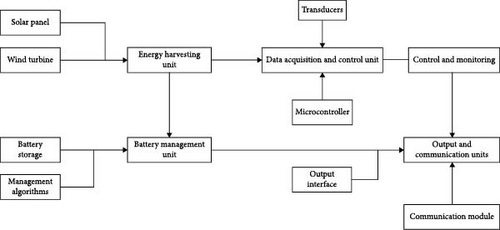
3.3. Principle of Operation and Efficiency of DC–DC Converters
Here, Rs represents the internal equivalent series resistance and Rload is the load resistance.
3.4. Dynamic Response and Stability
Here, τ represents the system’s time constant, reflecting the response speed; K is the gain, indicating the degree of impact of input changes on the output.
4. Evaluation Environment
This paper presents an intricate evaluation environment for a power management system tailored to EH applications. The environment consists of a simulated model and a hardware setup, providing a comprehensive platform for investigating the study’s research questions [23].
4.1. Simulation of the EH System
The simulation, crafted in Simulink, mirrors the hardware configuration, creating a realistic representation of the EH scenario [24]. It integrates various inputs, including solar irradiance, wind velocity, and rainfall intensity. A user-friendly interface permits interaction, allowing users to manipulate energy harvester inputs and storage options. In the solar cell module of the simulation, solar irradiance data is utilized to compute electrical power, leveraging a cell efficiency look-up table. The wind power module follows a similar approach, using wind speed to determine electrical output and referencing a turbine efficiency table. The rain harvester module, albeit less detailed due to data limitations, estimates kinetic energy from rainfall and its conversion to electrical power.
The simulation’s power management algorithm is streamlined, choosing the energy source with the highest power output at each interval. This approach, more efficient than its hardware counterpart, bypasses the delay inherent in reading power from multiple sources.
The simulation incorporates two distinct MPPT strategies: the perturb and observe (P&O) technique and the FOCV method. Special emphasis is placed on FOCV, aligning with its practical application in the real-world system. Each algorithm is engineered to achieve maximum efficiency within specific operational parameters.
DC–DC converters, pivotal in EH, are represented with varying efficiency levels determined by their design and power output. The simulation employs efficiency look-up tables derived from data on specific EH integrated circuits, shown in Figure 5.

4.2. Hardware Configuration
The physical aspect of the study involves an EH system enclosed in a 3D printed case, outfitted with external solar panels and wind turbines, shown in Figure 6.
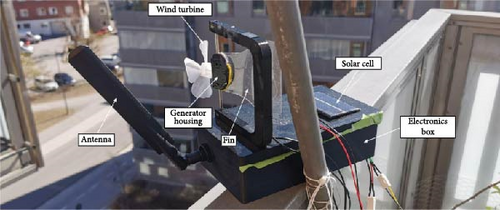
At the heart of this system is a Microchip SAM R34 microcontroller, responsible for computation and control. Optimization techniques were applied to minimize power consumption, thereby boosting the system’s overall energy efficiency.
Power monitoring is executed via a combined voltage and current sensor. This setup enables accurate tracking of the system’s energy consumption and output. The selection of solar cells and wind turbines is based on their suitability for EH, diversifying the energy sources utilized in the system.
The management of MPPT and battery charging is entrusted to a specialized integrated circuit, chosen for its congruence with the system’s design requirements. A lithium-ion battery, chosen for its capacity and dimensions, serves as the energy storage medium.
For communication, the system employs LoRaWAN, utilizing a public network for data relay. This arrangement facilitates remote monitoring and data analysis, essential for assessing the system’s operational efficacy.
In this paper, we meticulously detail the setup for experiments involving a simulation and hardware system in EH applications, highlighting the sources of weather data and the parameters utilized.
5. Experiment Setup for EH System
5.1. Experimental Setup
The experimental setup for our EH system is comprehensively detailed in this section, shown in Figure 7. A key aspect of our setup is the precise specification of the hardware used. Tables 1 and 2 provide a detailed list of all critical hardware components, their specifications, and their roles in the experiment.
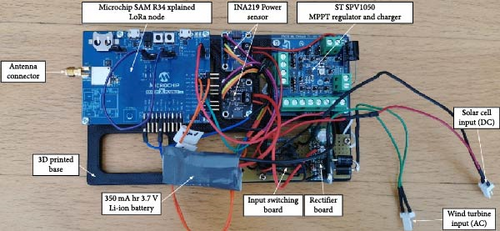
| Component | Model/specification | Role in experiment |
|---|---|---|
| Solar panel | SP-200 | Primary energy source, capturing solar power |
| Wind turbine | WT-100 | Secondary energy source, harnessing wind power |
| Microcontroller | Arduino Uno | Manages data acquisition and system control |
| Battery | Lithium-ion, 3.7 V, 1,000 mAh | Stores harvested energy |
- Abbreviation: EH, energy harvesting.
| Component | Model/specification | Role in experiment |
|---|---|---|
| Generator housing | GH-101 | Encases the turbine’s generator components |
| Antenna | AN-500 | Transmits data to remote monitoring locations |
| Fin | Aluminum fin | Stabilizes the wind turbine |
| Electronics box | EB-200 | Houses control electronics and power management |
The core element of this study’s simulation is meteorological data, encompassing measurements of solar irradiance, rain intensity, and wind speed. These metrics are pivotal in determining the energy yield of solar cells, rain harvesting mechanisms, and wind turbines. To facilitate this analysis, historical weather data from a variety of locations, predominantly in China, have been incorporated. This data is sourced from extensive meteorological databases, each station within these databases providing unique measurement frequencies and levels of accuracy [25].
To address instances where data gaps exist, typically due to instrumental errors or other anomalies, a replication strategy is implemented. This approach involves substituting missing data with information from prior days, thereby ensuring both consistency and temporal integrity within the dataset. Notably, while data pertaining to solar and rain measurements are largely complete, wind data at times presents sporadic gaps, though these instances are rare and limited in scope.
Visual representation of the weather data is a key aspect of this research, elucidating patterns in solar energy, as well as the more variable trends observed in wind speed and rain intensity.
5.2. Hardware System Placement
The physical setup of the EH system is strategically located on the balcony of a high-rise apartment, an environment conducive to unimpeded energy collection [26]. This positioning is chosen deliberately to maximize exposure to essential weather elements, thereby, optimizing the system’s operational efficiency.
5.3. Simulation Assumptions and Parameters
- (1)
The placement of the solar cell is horizontal, ensuring consistent and uniform exposure to sunlight.
- (2)
The wind turbine is constantly and optimally oriented towards the wind direction.
- (3)
All forms of precipitation are considered as rain, thus excluding the influence of snow on the solar cell and rain harvesting apparatus.
- (4)
The switching circuit within the system is assumed to have zero losses, representing an idealized scenario.
- (5)
All components involved in EH—namely the solar cell, wind turbine, and rain harvester—are continually exposed to environmental elements without any obstructions.
- (6)
The FOCV–MPPT algorithm is presumed to be 100% efficient, excluding the periods of open-circuit voltage sampling.
Parameters for the simulation are meticulously chosen to correspond with the physical characteristics of the actual hardware system and mirror standard values identified in related literature. These parameters cover a range of aspects such as microcontroller voltage, the maximum capacity for EH, and efficiency ratings for different components of the system. Self-discharge rates for both the battery and capacitor are derived from empirical studies, with the capacitor specifically modeled as a lithium ion type to simulate similar voltage characteristics as a battery, shown in Table 3.
| Parameter | Description |
|---|---|
| Battery type | Lithium-ion battery |
| Rated capacity | 1,000 mAh |
| Maximum charging current | 500 mA |
| Nominal voltage | 3.7 V |
| Cycle life | 500 cycles |
| Self-discharge rate | 2% per month |
6. Results
In this research paper, we delve into the analysis of various experiments conducted within a simulation environment, focusing on EH systems. These experiments encompass a range of tests, including the evaluation of different combinations of energy harvesters, the impact of varying energy storage capacities, and the influence of a power management algorithm on the system’s SoC.
This section provides a detailed examination of the basic parameters of the battery, which are vital for understanding the operational boundaries and performance characteristics of the battery in energy management systems.
6.1. Simulation Results
Experiments were conducted to evaluate various energy harvesters, all adjusted to yield similar average power levels. This study found that, in most cases, solar energy was the most efficient and dependable, requiring the least space for generating energy. However, when using a 350 mAh lithium-ion battery, the wind turbine was more space-efficient.
The area needed for the wind turbine stayed more or less unchanged across different battery sizes, unlike the solar cell, whose area requirement varied greatly. This variability is due to the seasonal changes in solar energy, with larger areas needed during low-energy periods like winter.
The average power output from each type of harvester was lower than figures often reported in the literature. Tests with various energy harvester combinations indicated that no single type could power the system all year round. Solar power was effective in summer but insufficient in winter, whereas wind power offered a steadier supply throughout the year. Combining wind and rain harvesters proved most effective in reducing system downtime, with the solar and wind combination next inline. A system integrating all three energy sources (Figure 8) was considered the most reliable for continuous power generation.
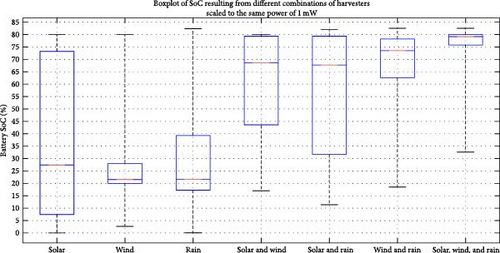
The SoC of the battery is plainly demonstrated in Figure 8 through the use of box diagrams, which demonstrate the fluctuation of the SoC in response to various EH configurations (solar, wind, rain, and their combinations). Figure 8 provides a detailed analysis of the fluctuations in battery SoC under a constant power output of 1 mW across various energy configurations, both single and combined. The analysis highlights distinct differences in performance:
Single energy configurations: Solar power displays a broad range of SoC, with a median approximately at 0.3, indicating its relative instability and dependence on sufficient sunlight. Wind energy, while experiencing narrower fluctuations, has a slightly lower median SoC of about 0.25, reflecting its vulnerability to wind speed variations that may result in extended periods of inadequate energy supply. Rain energy, although the least fluctuating, shows the lowest median SoC around 0.15, due to its lower availability and energy conversion efficiency compared to solar and wind.
Combined energy configurations: The combination of solar and wind energy demonstrates a synergistic effect, showcasing a higher median SoC of around 0.45 and reduced fluctuations, which points to the mitigated instability that either source would face individually. Combinations of solar and rain, as well as wind and rain, though improving SoC medians and reducing fluctuations, are not as effective as the combination of solar and wind. Notably, the integration of all three energy sources—solar, wind, and rain—yields the highest median SoC at about 0.65 with the least fluctuations, significantly enhancing system stability and reliability. This comprehensive evaluation underscores the benefits of diversified energy configurations in improving the robustness and effectiveness of energy systems, demonstrating that combining multiple energy sources can substantially stabilize and enhance the overall energy management framework.
A further comparative study focused on adjusting the harvesters to a uniform area, a common practice in situations with spatial limitations. In this scenario, when both solar and wind harvesters were scaled down to 2 cm2, neither experienced any deadtime individually. Yet, wind power encountered increased downtime, a result of its lesser power density relative to solar. At this size, integrating solar and wind energy sources proved effective in maximizing system uptime and minimizing downtime.
6.1.1. Energy Storage Capacity Analysis
The investigation into different energy storage sizes, using a combination of solar and wind power, revealed that larger storage capacities resulted in more stable SoC and reduced downtime. Even with a modest area of 2 cm2 for each harvester, the system maintained sufficient availability. This outcome demonstrated that combining EH sources can reduce the required area for achieving adequate power availability.
6.1.2. Impact of the Power Management Algorithm
The final aspect of the study focused on the effect of the power management algorithm on the system’s performance. Simulations were conducted with and without the algorithm to assess its impact. The results indicated that the absence of the algorithm led to increased deadtime, although it allowed for more frequent message transmissions, indicative of reduced downtime. However, this came at the cost of greater strain on the battery, especially when relying solely on solar power or combining solar and wind power. The use of the algorithm, in contrast, optimized the battery usage and reduced the instances of complete discharge, highlighting its significance in managing the EH system effectively.
In this paper, we present a comprehensive analysis comparing the outcomes of a hardware-implemented EH system with its simulated counterpart. This comparison aims to validate the accuracy of the simulation in reflecting real-world scenarios.
The hardware system was meticulously constructed to assess the effectiveness of the proposed algorithm beyond theoretical simulation. Data was collected from the system and transmitted as LoRa messages every 15 min, capturing key metrics such as solar and wind power and battery voltage. This data collection commenced on April 15th, 2022, providing a basis for a detailed comparative analysis.
6.2. Comparison with Simulation
A critical aspect of this study involved comparing the energy harvested by the hardware system with the simulated projections. For this purpose, the simulation parameters were meticulously updated to mirror the real system’s configuration as closely as possible. This included adjustments to the solar cell efficiency, microcontroller power consumption, and the system’s voltage limits, which were used in lieu of SoC limits for a more practical and direct comparison.
Notably, the analysis revealed that the real system’s solar panel was unable to surpass ~55 mW, a figure significantly lower than the over 250 mW peak observed in the simulation. To account for this disparity, a power limit of 55 mW was introduced in the simulation, aligning it more closely with the hardware system’s performance. The physical constraints of the system’s environment, such as the shadowing effects on the solar cell, were also considered, as they contributed to the lower power output in the late afternoon, a factor not accounted for in the simulation.
Further, the comparison of the wind harvester between the real system and the simulation indicated a substantial difference in power generation, with the real wind turbine producing considerably less power. This discrepancy led to the conclusion that wind power had minimal impact on the battery’s SoC, making the simulation more representative of the real system when only considering solar harvesting.
6.2.1. Statistical Analysis
A statistical comparison of the system’s battery voltage between the hardware implementation and the simulation was conducted (Figure 9). When wind power was excluded from the simulation, a higher correlation with the real system’s data was observed. This correlation was quantified using the Pearson correlation coefficient, and the significance of the differences was assessed using analysis of variance (ANOVA), as indicated in the detailed tables and figures.
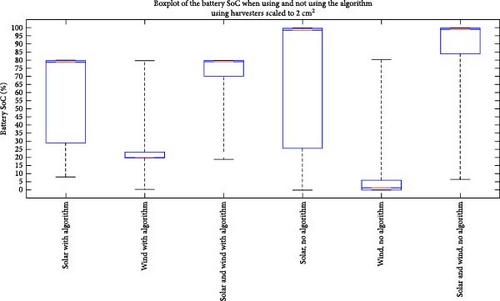
Despite the small p value indicating significant differences, the Pearson correlation coefficient suggested a strong correlation between the simulated and real-system voltages. This was particularly evident when wind power was excluded from the simulation, as shown in the provided box plot and statistical tables.
Figure 9 provides additional information regarding the influence of different energy configurations on battery SoC, both with and without the implementation of an optimization algorithm: Without algorithm: SoC demonstrates substantial fluctuations in all configurations, with generally low medians. This suggests that energy management efficiency is low without optimization, resulting in frequent low battery charge states. With algorithm: The algorithm substantially increases the median SoC and reduces fluctuations across the same configurations, thereby demonstrating effective management of energy inputs and battery charging/discharging. This, in turn, enhances battery efficiency and overall system stability. Altogether comprehensive contrast, it is evident that the efficiency and stability of the system are considerably improved by the use of an algorithm and diversified energy combinations when the data from Figures 8 and 9 is compared. In particular, the algorithm’s implementation enhances the average SoC and mitigates fluctuations across all configurations, underscoring the indispensable function of intelligent algorithms in the optimization of energy distribution and management, particularly in multisource energy systems. This optimization not only enhances energy utilization efficiency but also reduces maintenance costs and extends the life of batteries. In conclusion, this analysis underscores the challenges inaccurately simulating real-world environmental conditions and system constraints. While the simulation provided valuable insights, it became evident that certain practical aspects, particularly concerning the wind harvester, were not fully captured. Nonetheless, the strong correlation in solar power harvesting between the simulation and the hardware system highlights the simulation’s value in predicting system performance under specified conditions.
7. Discussion
7.1. Evaluation of EH Methods
The study initially investigated different EH methods such as solar, wind, rain, and RF to evaluate their effectiveness in powering a LoRa node consistently. It was found that solar panels and wind turbines, due to their superior average power densities, were the most suitable for this task. In contrast, harvesting energy from rain using piezoelectric elements and from RF sources proved to be inefficient. Their low power densities failed to meet the LoRa node’s typical energy demand of around 1 mW.
The research showcased that by combining a 2 cm2 solar cell and a similarly sized wind turbine, coupled with a compact lithium battery (350 mAh, 1,260 mW hr), a LoRa node requiring an average power of 1 mW could achieve 99% operational availability. This result highlights the benefits of using both solar and wind EH techniques together to provide a dependable power source for low-power devices such as LoRa nodes.
7.2. Smart Algorithm for Energy Source Selection
The second part of the research involved the development and implementation of a power management algorithm, both in simulation and hardware. This algorithm’s objective was to intelligently select the most available energy source at any given time. The implementation of this algorithm led to a decrease in system deadtime, where deadtime is defined as periods when the battery is completely discharged. Consequently, the system exhibited higher overall availability. However, the research also highlighted a tradeoff introduced by the algorithm. While it extended battery life by maintaining the SoC within certain limits, this also resulted in increased downtime, defined as periods when the SoC is below 20%, during which the system conserves power by not transmitting messages. The research concludes that the use of a capacitor alone or complete elimination of an energy storage element is not feasible for maintaining sufficient system availability. Therefore, a small battery or a large capacitor remains essential for ensuring the system’s effective operation.
8. Conclusion
The algorithm greatly enhances the overall availability of the system in a multi-input EH setting, with the combination of solar and wind energy being particularly advantageous in guaranteeing a continuous power supply. This combination enhances energy density and decreases dependence on bulky batteries or capacitors, hence facilitating a more cost-effective and eco-friendly system design. Furthermore, the algorithm efficiently facilitates uninterrupted system functioning and enhances energy efficiency by intelligently choosing the most appropriate energy source that is currently accessible.
In summary, this work has not only showcased the possibility of integrating solar and wind energy, but also confirmed the efficiency of the created algorithms using both real-world tests and computer simulations. These findings present new possibilities for managing energy in low-power wide-area network devices like LoRa nodes and contribute to the sustainable advancement of IoT devices. Subsequent studies will delve into the utilization of more sustainable resources and enhance energy management tactics to attain greater energy efficiency and system dependability. This will facilitate the global adoption and environmental sustainability of low-power gadgets.
Conflicts of Interest
The authors declare that they have no conflicts of interest.
Authors’ Contributions
Peng Ying contributed to conceptualization, software, visualization, and writing. Xing Shen contributed to software. Xuzhen Jing contributed to project administration and funding acquisition.
Acknowledgments
This work was supported by National Natural Science Foundation of China (12111540251).
Open Research
Data Availability
All the relevant data are within the paper.




